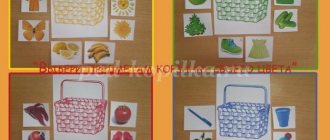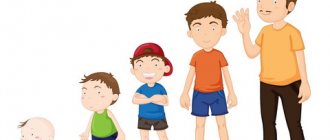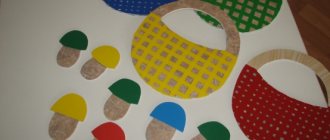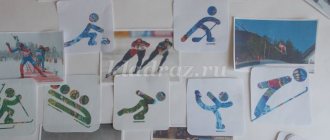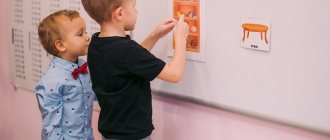Lapbook "Transport"
A laptop on the topic “Transport” is intended for children in the middle, high school and preparatory school groups. It will also be interesting for younger schoolchildren, and expand children’s knowledge of cognitive development.
Goal: To consolidate children's knowledge about different types of transport.
The first spread contains pictures depicting roads, rails, clouds, water and pockets with modes of transport: air, water, land, rail.
Didactic game “Arrange correctly”
Goal: To consolidate children's knowledge about types of transport.
Children's task: it is necessary to place pictures depicting different types of transport in the places where they move (ground - road, water - water, air - clouds, rail - rails).
Didactic game “Who controls what?”
Goal: To consolidate children's knowledge about professions.
Children's task: it is necessary to place images of a person in a work suit in the pocket with the transport he controls (driver - rail transport, captain - water transport, pilot - air transport, driver - ground transport).
The second spread contains information about parts of transport, the history of transport development, and types of special-purpose transport.
Didactic game “Parts of transport”
Goal: To consolidate children's knowledge about parts of transport
Children's task : you need to look at a card with a picture of transport and name the parts of transport that it consists of.
Little book “History of transport development”
Goal: To consolidate children’s knowledge about the history of transport development
This little book contains information about the history of the development of land transport (from a horse-drawn carriage to a modern car), about the history of the development of air transport (from the wings of Icarus to a modern airplane), about the history of the development of water transport (from a raft to a modern ship)
Didactic game "Special transport"
Goal: To consolidate children’s knowledge about special transport, professions, and the call number for special transport.
Children's task: it is necessary to place call numbers for special transport with the image of the special transport that will come to this call, to place pictures with the image of a person of the required profession on the transport in which they will come to help.
The third spread contains information about freight and passenger transport and the game “Help the Car”
Didactic game “Freight and passenger transport”
Goal: To consolidate children's knowledge about freight and passenger transport
Children's task: it is necessary to distribute passengers into the bus, cargo into the truck.
Didactic game “Help the car”
Goal: to consolidate children’s knowledge about car repair and car services
Children's task: you need to select pictures - the car has run out of gas - gas station, the car has a broken wheel - tire service, the car has broken down - car service.
Nomination: didactic games for preschoolers. Author: Demina Elena Mikhailovna Position: teacher of the 1st qualification category Place of work: MKDOU - Chernakovsky kindergarten "Teremok" Location: Chernakovo village, Ordynsky district, Novosibirsk region
Date modified: April 21, 2020
Lepbook “Transport”
- June 28, 2018
International and All-Russian competitions
All-Russian master class “Lapbook as a learning tool in the context of the implementation of the Federal State Educational Standard for Education”
Lepbook “Transport”
Petinova Elena Vladimirovna, teacher of the 1st qualification category
MBDOU General developmental kindergarten "Golden Key"
Zheleznogorsk-Ilimsky, Irkutsk region
A little theory
Lapbook is a relatively new means of teaching children from America. In the USA, laptops are successfully used in home schooling for schoolchildren.
Lapbook – literally translated from English as “knee book” (lap – knees, book – book). Thus, attention is immediately focused on the size of the laptop - small (usually A4 format), so that the child can easily place it on his lap and on the fact that the laptop is most often an individual creation.
A laptop or thematic interactive folder is a homemade paper book with pockets, doors, windows, and movable parts that a child can take out, rearrange, and fold at his own discretion. It collects material on a specific topic.
Why do you need a laptop?
- It helps the child organize information on the topic being studied at will and better understand and remember the material (especially if your child is visual).
- This is a great way to review what you've learned. At any convenient time, the child simply opens the laptop and happily repeats what he has learned, looking at the book he made with his own hands.
- The child will learn to independently collect and organize information - good preparation for writing essays and term papers.
- Creating a laptop is one of the types of joint activities between an adult and a child (children).
- A laptop is a way to develop a children's project (integrator of joint activity products).
- A laptop is a product of children's activities based on the results of a thematic block.
- The laptop is a meaningful element of the developing subject-spatial environment of the group.
- And finally, it's just fun!
I created the “Transport” laptop book together with the children of the senior group “Fidgets” (5-6 years old). The children, together with me, created a laptop design (plan), participated in the selection of information and, of course, cut, glued, and painted. Maybe our laptop turned out not very beautiful and neat, but it was made with our own hands and this gives it special educational value.
The laptop is in great demand among children (this can be seen from its slightly shabby appearance), but I consider this fact as definitely positive.
Contents of the laptop or how we play with it
- “Geometric constructor” Children make various vehicles from geometric shapes (circles, triangles, rectangles and squares). This can be done either by presentation or based on a picture or diagram. The game promotes the development of spatial imagination and thinking.
- “Little book with riddles” The book contains riddles on the topic (15). Children love to solve riddles, my children and I constantly come up with new ways, for example, we guess by command, by the first line, instead of answering, we quickly find the right picture and silently lift it up (silent riddles), we learn riddles by heart and tell each other riddles.
- “Parts and the Whole” Boys love this part of the laptop, because with the help of moving pictures you can study the structure of a car, ship and airplane.
- “Before and Now” or timeline. Inside the miniature books we placed images of modern transport (ships, planes, trains and cars), and on top, as a cover, photographs of an ancient steamship, airship, first trains and cars. Children love to find similarities and differences between pictures, figuring out the purpose of details they do not understand.
- “Car brands” We selected the most famous car emblems all over the world (Alfa Romeo, Mazda, Opel, Audi, Renault, etc.) and printed them in duplicate for the “Find a Pair” game. We also use these pictures for the memory game.
- The interactive envelope “Modes of Transport” gives an initial understanding of land, air, water and underground transport.
There is both water and air.
The one that moves on land
It carries cargo and people.
What is this? Tell me quickly!
7. Pockets “Special transport”, “Public transport”, “Personal transport” The pockets contain color illustrations of various types of transport. We use them for classification, in order to develop speech (“Name”, “Describe”, “Remember the riddle”, “Make up a story”, etc.).
This is not a complete list of how you can use a laptop (for example, we arrange presentations for kids) or come up with new games.
Free Internet resources were used to make the laptop.
